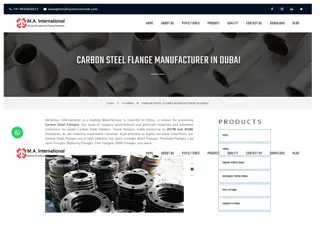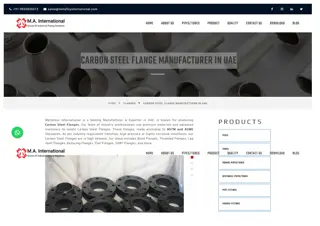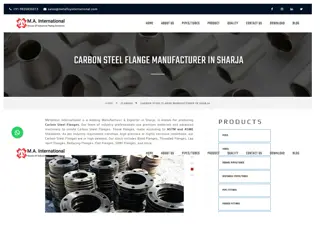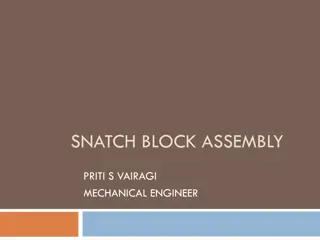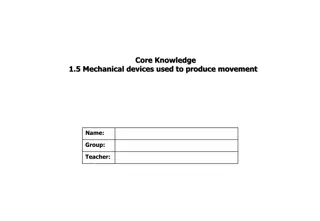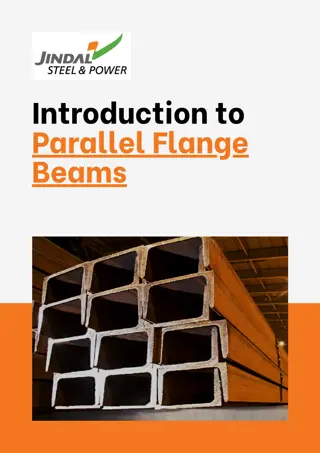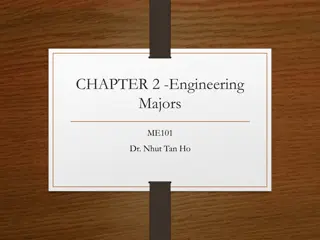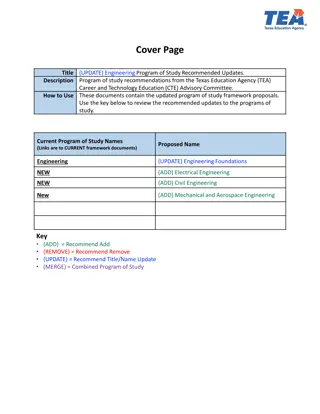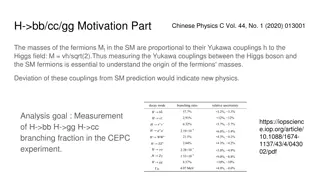Design of Flange Couplings in Mechanical Engineering
This detailed guide covers the design process of coupling components such as shafts, keys, bolts, and flanges for transmitting power efficiently in mechanical systems. It discusses calculations for selecting dimensions, stress considerations, types of flange couplings, and their applications in heavy-duty machinery.
Download Presentation

Please find below an Image/Link to download the presentation.
The content on the website is provided AS IS for your information and personal use only. It may not be sold, licensed, or shared on other websites without obtaining consent from the author.If you encounter any issues during the download, it is possible that the publisher has removed the file from their server.
You are allowed to download the files provided on this website for personal or commercial use, subject to the condition that they are used lawfully. All files are the property of their respective owners.
The content on the website is provided AS IS for your information and personal use only. It may not be sold, licensed, or shared on other websites without obtaining consent from the author.
E N D
Presentation Transcript
COUPLING Part II Lec.14 Prod.Eng.& Mech. Design Dept. Faculty of Engineering
Example (2) Design a clamp coupling to transmit 40 h.p. at 100 rpm the allowable shear stress for the shaft and key is 400 kp/cm2and the number of bolts connecting the two permissible tensile stress for the bolts is 700 kp/cm2. The coefficient of friction between the muff and the shaft surface may be taken as 0.3. halves are six. The Solution P = T 4500 P = = T 2 n 4500 x 40 = = T 100 x 2 = = T 28640 kp cm .
I. Design Of Shaft: 16 T 16 x 28640 3 3 = = = = = = d 364 5 . cm x 400 d = 7.144 cm = 7.5 cm = 75 mm II. Design of muff: D = 2 d + 13 = (2)(7.5)+1.3 = 16.3 cm = 16.5 cm L = 3.5 d = (3.5X7.5) = 26.25 cm
III. Design Of Key From the table of the standard keys, the following dimensions can be choose for the shaft with diameter (d = 75 mm) w = 22 mm & t = 14 mm Length of the key = the total length of the muff i.e.; L = 26.25 cm IV. Design Of Bolts: Using the following relation 16 2 T 2 b = = d nd 2 t 2 b = = T d nd 16 x 2 28640 t 16 = = 0 . 3 x x x 700 x 6 x 7 . 5 = = 4 . 914 = = = = d 2 . 215 cm 2 . 5 cm 25 mm b
5. FLANGE COUPLING A flange coupling consists of two separate cast iron flanges that can be used to connect two in-line shafts. The following conditions should be noticed by flange couplings: - Each flange is mounted on the shaft end and keyed to it. - The faces of the flanges should be turned to ensure right angle with the axis of the shaft. - To maintain alignment, one of the flanges should have a projected portion while the recess. other have a corresponding - The two flanges are coupled together by means of bolts.
In general, the flange couplings are used for heavy duty and hence they are used for connecting of large shafts. However, this type can be classified into the following mean types: - Unprotected type. - Protected type. - Marine type. In the unprotected type, each shaft is keyed to the boss of the flange with a counter sunk key and the flanges are coupled together by means of bolts. Generally, 3, 4 or six bolts are used. The keys of the shafts are adjusted to be at right angle along the circumference of the shaft to minimize the weakening effect of the keyways.
Flange Key Shaft Nut Bolt
5.2 Protected Flange Coupling Here, flanges on the two halves of the coupling protect the head of bolts and nuts in order to avoid danger to the workman. The following figure shows this type.
The usual proportions of the cast iron flange coupling are as follows: d : Diameter of shaft or inner diameter of the hub. - Hub outside diameter D = 2d - Length of the hub = 1.5 d - Flange thickness t1 = 0.5 d Thickness of the protective circumstantial flange = 0.25 d Number of bolts: = 3 for (d) upto 40 mm = 4 for (d) upto 100 mm = 6 for (d) upto 180 mm
5.3 Marine Flange Coupling In marine couplings, the flanges are forged integral with the shafts as shown in the figure. The flanges are connected to each other by means of tapered headless bolts numbering from 4 up to 12 depending diameter of the illustrated in table. type of flange on the as shaft Shaft Diameter mm No. of Bolts 35-55 56-150 151-230 231-390 >390 4 6 8 10 12
The special proportions for marine coupling are: Thickness of Flange Taper of bolts = 1 : 20 to 1 : 40 Bolt pitch circle diameter = 1.6 d = d/3 Dimensional Properties: Because of parameters, the proportions of rigid flange couplings obtained from practically proved values. the interacting can be The design is then limited to modifying or checking those proportions to the particular application. Check must be made on couplings when large bending moments could not be avoided.
The proportions for cast iron and cast steel flanges are given below in terms of the shaft diameter d in mm . Refer to the shown figure: The number of bolts is N , then; 1. The number of Bolts N : N = 0.02 d + 3 and N = 3 if d < 40 mm 2. Bolt Diameter d1: The bolt diameter d1 is approximately taken as: d d1= = n 2 But, the diameter must be checked for load requirements (under shear stress).
3.Bolt Circle Diameter D1: D1 = 2( d + 25 ) 4.Hub Diameter D2 : D2 = 1.5 d + 25 mm and D2 2 d 5.Hub Length L : L = 1.25 d + 20 mm and L 1.5 d 6.Outside Diameter D : D = 2.5 d + 75 and D 5 d 7.Flange Thickness t : t = 1.2 d1 and must be checked for shear. 8.Safety Flange Thickness f : f = 4 mm for cast iron f = 6 mm for cast steel.
7. DESIGN PROCEDURE: The important data that should be given are: 1. The transmitted power P 2. The shaft speed N . 3. The shaft diameter d . The following steps should be carried out: 1. Determine n, D1(bolt center diameter), D2(hub external diameter) , D (hub internal diameter = shaft diameter d and L (hub length) from the given empirical formulas. 2. Determine the tangential force per bolt necessary to transmit the required power (torque at certain velocity) considering a safety factor of 2. 3. Check or determine the bolt diameter d1 . If the bolts are fitted, they must be check for shear and crushing assuming that half the number of bolt will carry the load.
Shear stress in Bolt: 4 F = = t 2 1 d Crushing of Bolts: F = = t c td 1 4. Check the flange thickness t for shearing at the hub. 2 Torque 2 2 = = D t 5. Determine the shaft key dimensions.
6. The flange width b must be large enough to allow the safety flange to cover the bolts.
8. Hub Design Design of hub can be carried out by considering the hub as a hollow shaft, which transmits the same power (torque at specific speed), i.e., 4 2 4 D d = = Torque ( ) s 16 D 2 = = 4 1 ( s k ) 16 k = d/D2 Where, N.B: Hub length = 3 D2
PROTECTED RIGID COUPLING 10:1 54 90 79 150 80 100 210 4.5 79X9X14 90X9X14 50 7.5 1.5 1.5 2 2 4 9 1 4 M16 R 1.5 8 2 20 20 45 45 7 5 4 6 3
FLEXABLE COUPLING 5 3 4 6 7 8 2 9 18 1 10 10:1 40 65 36 60x8x10 5 45 45 70 70 1 Key 60x8x10 (2) 2 pin (4) 3 Disc (1) 4 Nut M16 (4) 5 Washer 16x3 (4) 6 Spacer (4) 7 Gumi Nut (20) 8 Disc (1) 9 Pin (4) 10 Shaft End (2)
Example(3) A rigid flange coupling has a bore diameter of 50 mm. Four bolts on a bolt circle of 125 mm diameter are fitted in reamed holes. If the bolts are made from the same material as the shaft, with an ultimate tensile strength of 550 MPa and a yield point in tension of 345 MPa, determine the necessary size of the bolts to have the same capacity as the the shaft in tension. Solution Initially, the torque should be determined as follows: M D 2 M r = = t = = t 4 D I p 32
3 D = = M t 16 = = = = . 0 18 or 3 . 0 u y = = = = = = = = . 0 18 550 MPa 99 or 3 . 0 345 MPa 5 . 103 5 3 ( 99 10 )( . 0 05 ) = = = = = = M 97143 . 75 N mm . . 0 97 kN m . t 16 The design value of the twisting moment can be considered as the result of Mt devided by the stress concentration factor Kt . Mtd= Mt/ Kt Mtd= 0.97 / 0.75 = 1.295 kN.m
The analysis of the bolt design can be carried out in one of the following several ways: 1. Assume that the bolts are just finger-tight, and the load is transmitted from one half of the coupling to the other by uniform shear stress. 2. Assume that the bolts are tightened sufficiently, and the load is transmitted from one half of the coupling to the other by means of friction. In our case, design based on shear stress can be used: M = = F t bolt r n Fbolt N : Number of bolts R : Radius of bolt circle : Force per bolt
3 . 1 295 10 = = = = F 5180 N 125 . bolt 4 2 4 F = = t 2 1 d 4 5180 2 = = 99 d 4 5180 = = = = d . 8 16 mm 99 The bolt required is M10 .
Example(4) A rigid flange coupling has the following data: - Number of bolts - Size of bolts - Bolt preloading - Shaft diameter - Outer coupling diameter - Inner coupling diameter - Rotational speed - shaft material is 0.45% steel with ultimate strength o586 MPa and yield point in tension of 310 MPa. 1. Evaluate the maximum coupling power capacity based on friction such that slip occurs between faces of contact. 2. Compare the shaft horse power capacity with the friciton horse power capacity assuming steady state load condition and that the shaft is in torsion only. 6 12 mm, (M12) 22 kN 50 mm 200 mm 175 mm 200 rpm. 200 175 50
Solution In the design of rigid couplings, it is assumed that the bolts are loosed in service and the coupling capacity is based on the generated stress due to shearing. The tightening effect of the bolts; with friction as the base of power transmission is generally neglected. However, it is required here to evaluate the capacity of the given coupling based on friction.
Example(2) A rigid flange coupling has the folllowing data: Solution Initially, the torque should be determined as follows: M D 2 M r = = t = = t 4 D I p 32



